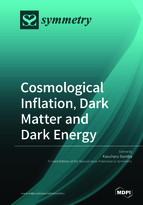Cosmological Inflation, Dark Matter and Dark Energy
A special issue of Symmetry (ISSN 2073-8994). This special issue belongs to the section "Physics".
Deadline for manuscript submissions: closed (30 June 2019) | Viewed by 39514
Special Issue Editor
Interests: particle cosmology; gravity theory; inflation; late time acceleration
Special Issues, Collections and Topics in MDPI journals
Special Issue Information
Dear Colleagues,
Based on the recent cosmological observations, such as Type Ia Supernovae, cosmic microwave background (CMB) radiation large scale structure, baryon acoustic oscillations (BAO) and weak lensing, the universe has experienced the accelerated phase of its expansion not only in the early universe but also in the present time. The former is called "inflation" and the latter is called "the late-time cosmic acceleration". It is also well known that the three energy components of the universe are dark energy (about 68%), dark matter (about 27%) and baryon (about 5%).
A number of studies have been executed for the origins of the field to realize inflation, dark matter and dark energy, which are most fundamental problems in modern physics and cosmology. The future detection of the primordial gravitational waves is strongly expected in order to know the energy scale of the inflationary phase. Moreover, there are two possibilities for the origin of dark matter, namely, new particles in particle-theory models beyond the standard model and astrophysical objects. Furthermore, there have been proposed two representative studies for the true character of dark energy. One is the introduction of some unknown matter called dark energy with the negative pressure in the framework of general relativity. The other is the modification of gravity at large scales, leading to the so-called geometrical dark energy.
The main aim of this special issue is to understand various cosmological aspects of inflation, dark matter and dark energy. In addition to the phenomenological approaches, more fundamental studies are considered from higher-dimensional theories of gravity, quantum gravity and quantum cosmology, physics in the early universe, quantum field theories and gauge field theories in curved spacetime, and strings, branes and holographic principle. It is very pleased to receive submissions to this special issue on inflation, dark matter, dark energy and related foundations of physics.
Prof. Dr. Kazuharu Bamba
Guest Editor
Manuscript Submission Information
Manuscripts should be submitted online at www.mdpi.com by registering and logging in to this website. Once you are registered, click here to go to the submission form. Manuscripts can be submitted until the deadline. All submissions that pass pre-check are peer-reviewed. Accepted papers will be published continuously in the journal (as soon as accepted) and will be listed together on the special issue website. Research articles, review articles as well as short communications are invited. For planned papers, a title and short abstract (about 100 words) can be sent to the Editorial Office for announcement on this website.
Submitted manuscripts should not have been published previously, nor be under consideration for publication elsewhere (except conference proceedings papers). All manuscripts are thoroughly refereed through a single-blind peer-review process. A guide for authors and other relevant information for submission of manuscripts is available on the Instructions for Authors page. Symmetry is an international peer-reviewed open access monthly journal published by MDPI.
Please visit the Instructions for Authors page before submitting a manuscript. The Article Processing Charge (APC) for publication in this open access journal is 2400 CHF (Swiss Francs). Submitted papers should be well formatted and use good English. Authors may use MDPI's English editing service prior to publication or during author revisions.
Keywords
- inflation
- dark matter
- dark energy
- cosmology
- modified gravity theories
- higher-dimensional theories of gravity
- quantum gravity and quantum cosmology
- primordial gravitational waves
- physics in the early universe
- particle-theory models beyond the standard model
- quantum field theories and gauge field theories in curved spacetime
- strings, branes and holographic principle






